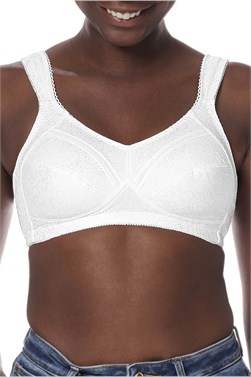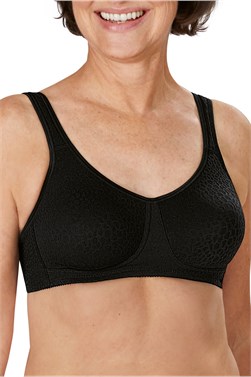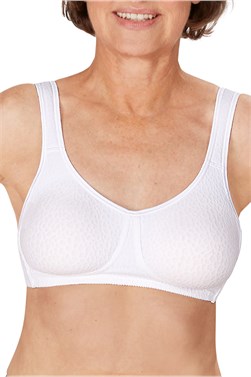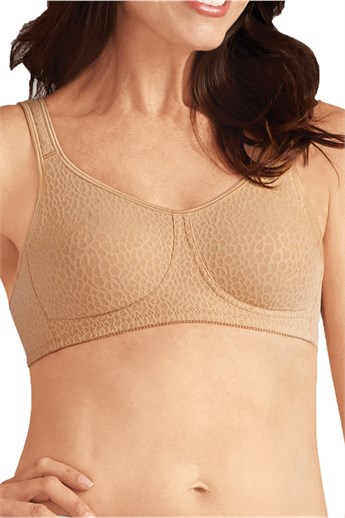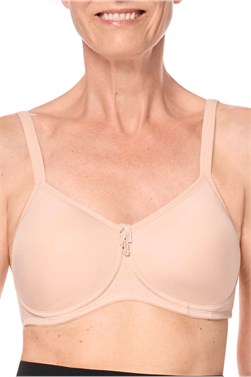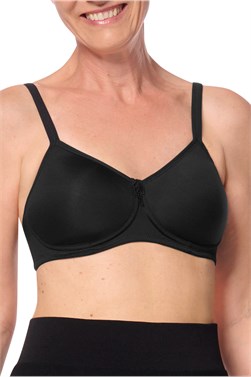Being a Mastectomy Fitter
Who is the woman that fits your bra and what drives her deep desire to help others?

Our culture views breasts as sexual and feminine. Some women find them integral to their sense of womanhood and identity. Losing one or both can therefore be upsetting, leaving some with a real sense of loss both in terms of shape and femininity.
A beautiful mastectomy bra can work wonders – allowing you to regain the natural shape of your breast or compensate for any missing breast tissue, with the simple yet discrete inclusion of pockets - specifically designed to easily and securely hold breast forms (breast prosthesis) in place.
Mastectomy lingerie is an integral part of the post-surgery recovery process. Further down the line pocketed swimwear and loungewear can also form an important part of a breast cancer survivor’s everyday life.
Whether your surgery was months or years ago, a trained mastectomy fitter can help you find lingerie that is comfortable, looks good, and feels sexy too. “My mission is to help women feel great and say ‘hurray’ on the inside, outside and underneath,” says Kim Caldwell, a New York City-based bra fitter who has years of experience and expertise in helping women select undergarments for post-mastectomy.
“The sharpest tool I have to help a woman feel good about her body post-mastectomy is bra fitting,” she adds. And that’s not a challenge anymore. “Today’s mastectomy bras are so gorgeous that any woman – mastectomy, lumpectomy, natural – would feel her very best wearing them. And no one will ever be able to tell” that she’s wearing post-mastectomy lingerie.
Mastectomy fitters undergo specialized training and often are required to meet specific certification criteria. Some can also help you pick out breast forms. Typically, you need to make an appointment, which can last anywhere from 20 minutes to an hour.
What Happens At A Fitting?
Initially your doctor may need to give you the go-ahead to get be fitted for a mastectomy bra. These fittings typically take place either in a medical setting, such a hospital or pharmacy shop, or in a lingerie/department store.
Wherever you go for your fitting, you should bring your breast form with you – if you have one – and one or two of your favorite tops. That way, you can make sure the bra you choose will work for you in what you’re used to wearing. “You should expect to look good in anything you wear – within reason of the surgical site,” says Deb Poss, owner of Naturally You, a specialty boutique located outside of Toronto, Canada.
If you bring your favorite bra, your fitter can check it out, too. “Sometimes the best choice is the bra you already own,” says Poss.
“You can also bring a family member or friend,” suggests Clare Gibson, fitting consultant at Amoena’s showroom in Hampshire, England. “The fitting room can be a very intimate space to share with a fitter you barely know,” agrees Caldwell, and it can help to have emotional support.
Fitters typically start by asking what you need: Are you looking for a compression bra (for right after surgery), or a pocketed bra? Are you going to have radiation, which can change your chest wall? (Most fitters recommend waiting until after radiation to get new bras.) What are you looking for in a bra: Are you shopping for the gym or for a special occasion?
Your fitter will measure the circumference of your ribcage and, if relevant, your remaining breast, which “serves as a template,” says Poss. She may pick out several styles and let you try them on to check for weight, shape and fullness, Gibson adds.
Making a Difference
The right lingerie – and the right fitter – can help a woman come to terms with her new post-mastectomy body, says Caldwell. She tells about a woman who’d undergone a bilateral mastectomy and was very nervous about the fitting. When Caldwell asked what type of bra she wanted, she whispered, “something pretty.” Caldwell picked out a few, but it was the soft one with the deep plunge, delicate straps, and red floral applique that did the trick. “It’s beautiful. I’m beautiful,” the woman gasped. “I just never thought I could feel like a woman again. Thank you!” Both Caldwell and the client ended up in tears of joy.
Even if the response is more subtle, a fitter can always tell how a woman is reacting. “When a woman comes in, she might be feeling tense and be slightly hunched over,” Gibson explains. “When she leaves, she walks out with her head held high.”
How to Become a Mastectomy Fitter
If you’re thinking about becoming a mastectomy fitter, it helps to be comfortable with women’s bodies, in all shapes and sizes, with and without scars. Compassion and a wonderful bedside manner are key. “A woman may be embarrassed about her body,” says Gibson. “You need to be matter-of-fact and reassuring.”
You also need to be a good problem-solver, says Caldwell. You never know who’s going to walk in the door.
A medical background can be helpful but it’s not essential. Poss was a respiratory therapist and Gibson trained as a massage therapist and both have found it useful. Caldwell, who came to the field from lingerie, has found that the training process gave her all the technical knowledge she needs. Enthusiasm and compassion, she asserts, are harder to teach.
Amoena offers fitter training in the United States several times a year in various cities. Our Introductory course is just that – an introduction to how to fit mastectomy bras and breast prostheses. After taking it, and completing the required minimum number of hours of actual fitting, you can sit for a certification exam, administered by one of the national accrediting boards. It’s a career worth considering.
A compassionate and competent mastectomy fitter can go a long way toward helping women learn to love their bodies again.







